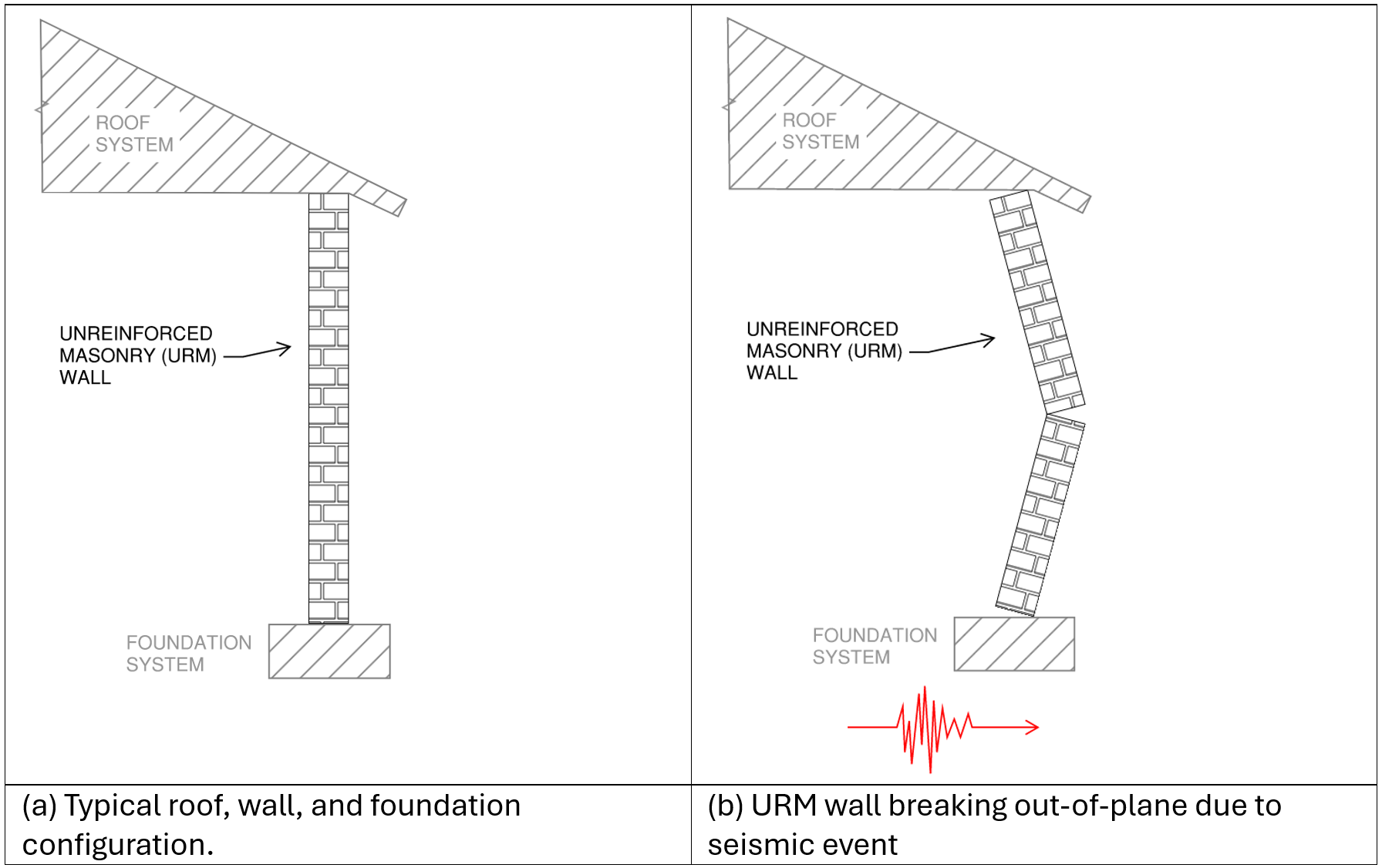Why do I care?
Did you know that the type of mortar used in old buildings can significantly affect their safety during earthquakes? Many older buildings, especially those built before the 1950s, were made with bricks and mortar but without the steel bars that modern buildings use for extra strength. This type of construction, called unreinforced masonry (URM), has not performed well in past earthquakes (FEMA, 2009). The lack of reinforcement is a major contributor to this poor performance. However, the type of mortar used to construct these buildings also has a notable influence on their actual seismic performance. This influence is most easily seen when looking at the out-of-plane shaking of a URM wall. Earthquakes can cause the walls to break at mid-height and fall inward or outward – see Figure 1.

Mortar — what is it?
Think of mortar as the glue that sticks the bricks together. The mortar is seen in between the bricks shown in Figure 2. Not all mortars are created equal. Today's mortar is a mix of cement, lime, and sand. In the past, mortar was often just lime and sand. The proportions of cement and lime will impact the strength of the mortar. So, when considering the seismic vulnerability of a URM building, mortar type matters.

Typical mortar types are shown in Table 1 where proportions of cement and lime are listed. Mortar strengths improve with higher cement content. A new masonry building today will most likely use type S mortar. As late as the early 1900s, it was not uncommon to have buildings constructed using lime, type K, or type O mortars. URM buildings with these mortars will have a lower seismic strength. For instance, an 8-foot-tall unreinforced masonry (URM) wall that's two bricks thick and uses type N mortar can handle six times more earthquake shaking than a similar wall made with lime mortar.

How can I tell if my building has lime mortar?
Curious if your building has lime mortar? Here’s how you can find out! A quick internet search will probably suggest checking the color or doing a vinegar test. While both of these checks are easy to perform, they can be tricky to interpret.
Color Check
For the color check, you need to compare your mortar sample with known samples side-by-side. Lime mortar is usually whiter, while cement-based mortar tends to be more grey. This can be tricky because historical mortars are often so dirty or stained that it's hard to see their true color.
Vinegar Test
The vinegar test is a simple way to check for lime in mortar because vinegar reacts with lime. Just crush a sample of the mortar, add some vinegar, and see if it fizzes. However, since all mortars contain some lime, they will all react to vinegar to some extent. This means you need to compare your sample with a known type of mortar to judge the fizzing accurately. Even then, it can be tricky to tell the difference.
In the video below, we add vinegar to two mortar samples from different buildings. One sample is from a building constructed in the 1910s and is likely mostly lime. The other is from a 1990s building and is probably type S mortar (2 parts cement, 1 part lime). Watch the video and see if you can tell which is which just by the fizzing. It's not easy, even with this side-by-side comparison!
Scratch Test
The national standard for evaluating existing buildings (ASCE 41-23) implies that the previous checks aren't always reliable – see Figure 3. According to the standard, if you can scrape the mortar out of the joints without using power tools, it's likely lime or mostly lime mortar. In the video below, we crush two mortar samples by hand—one from the 1910s and one from the 1990s. You can clearly see that the older mortar is much weaker than the newer one.

Chemical Test
All the checks we've talked about so far have some level of subjectivity. For a more definitive answer, you can get a chemical analysis done. There are testing agencies that can perform this formal analysis for you. Figure 4 shows the results from a mortar sample taken from a 1911 building in Salt Lake City, Utah. Even though this mortar contains cement, it's still one of the weaker types.

Take-Away
The best way to detect lime mortar is by doing a scratch test or a chemical test. If you live or work in an area prone to earthquakes, it's smart to have any unreinforced masonry (URM) buildings checked for their seismic performance. This is especially important for URMs with lime or weak cement-based mortar. The good news is that there are ways to strengthen these buildings to improve their earthquake resistance.
References
ASCE, “Seismic Evaluation and Retrofit of Existing Buildings.” ASCE 41-23. American Society of Civil Engineers, 2023.
FEMA, “Unreinforced Masonry Buildings and Earthquakes.” FEMA P-774. Federal Emergency Management Agency, 2009.








